Imagine being in the meat aisle, surrounded by many cuts. Each one promises a unique taste and texture. You feel excited but unsure.Understanding your beef loin flat iron steak label can change your cooking game. It’s not just about food; it’s about quality, freshness, and history. When you read those labels, you unlock secrets to better cooking and enjoying your food more.
The label on your beef loin flat iron steak is a guide. It tells you about grading, where it comes from, and its nutrition. Knowing about beef labels lets you make better choices. It connects you to your food and the way it’s made. Learning about this can change how you see a steak.
Table of contents
- Introduction to Beef Loin Flat Iron Steak
- What is Flat Iron Steak?
- Characteristics of Beef Loin Flat Iron Steak
- The Importance of the Beef Loin Flat Iron Steak Label
- Understanding the USDA Grading System
- Key Elements of Your Beef Loin Flat Iron Steak Label
- Cooking Instructions for Flat Iron Steak
- Flavor Profiles and Marinades
- Health Benefits of Beef Loin Flat Iron Steak
- Sustainability and Ethical Considerations
- Tips for Selecting Quality Flat Iron Steak
- Conclusion
Introduction to Beef Loin Flat Iron Steak
The beef loin flat iron steak is loved by many for its great taste and softness. It comes from the cow’s shoulder, blending rich flavor with a texture that many enjoy. It’s perfect for grilling, broiling, or pan-searing, making it a favorite among cooks.
From a 1,400-pound cow, you can get about 80 pounds of steak. This includes the flat iron steak, which is great for those who love beef. It’s perfect for quick meals or special dishes, without needing to spend hours in the kitchen.
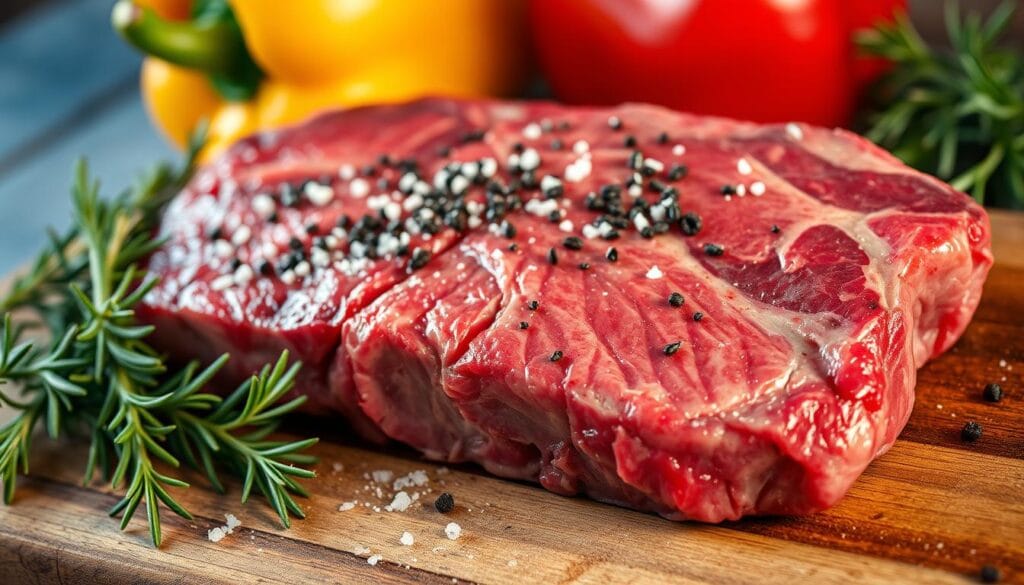
Knowing what makes the beef loin flat iron steak special can make your cooking better. It’s great for many dishes, from fast dinners to fancy meals. You can season it simply or marinate it for more flavor, meeting your steak preferences.
What is Flat Iron Steak?
Flat iron steak comes from the beef loin, near the cow’s shoulder. It’s known for being tender, almost as tender as filet mignon. People love it because it’s easy to cook and affordable, making it perfect for family dinners and restaurants.
The way flat iron steak is cut is what makes it special. It’s shaped like a flat iron, which is why it’s named that way. This cut is full of marbling, which means it tastes richer than other steaks like flank steak.
The USDA grades flat iron steak, just like other beef. The highest grade, Prime, has lots of marbling. This makes the steak tender and flavorful. So, flat iron steak is a great choice for those who want quality without breaking the bank.
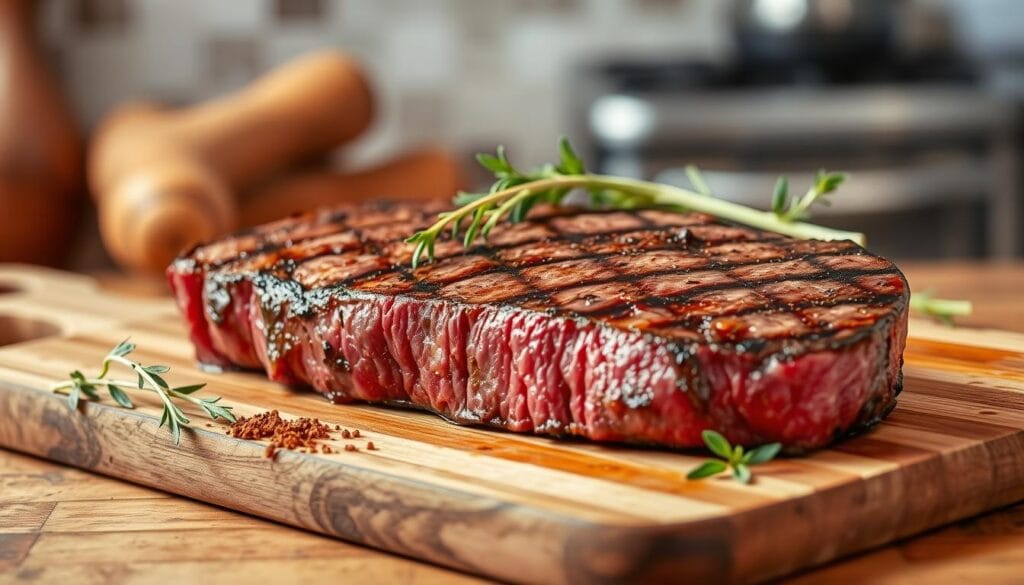
| Characteristic | Details |
|---|---|
| Cut Location | Shoulder (Chuck) |
| Tenderness Ranking | Second to Filet Mignon |
| Comparison with Ribeye | Rival in Texture and Flavor |
| Common Cooking Time | 4-5 minutes per side for medium rare |
| Internal Temperature for Medium Rare | 130°F (54°C) |
| Storage Temperature | 32–34°F |
Characteristics of Beef Loin Flat Iron Steak
The beef loin flat iron steak is known for its beef loin characteristics. It has a fine marbling pattern that makes it tender and flavorful. This steak is perfect for grilling or sautéing.
It’s about ¾ to 1 inch thick and looks vibrant red when fresh. Its looks and taste make it a hit with steak lovers.
One of the flat iron steak traits is its versatility. It’s great as a main dish or in salads and sandwiches. Its fine grain and marbling ensure it stays juicy and flavorful, no matter how it’s cooked.
The flat iron steak is among the tender beef cuts. It’s almost as tender as a rib-eye. This makes it a joy to eat, with its wonderful textures and tastes.
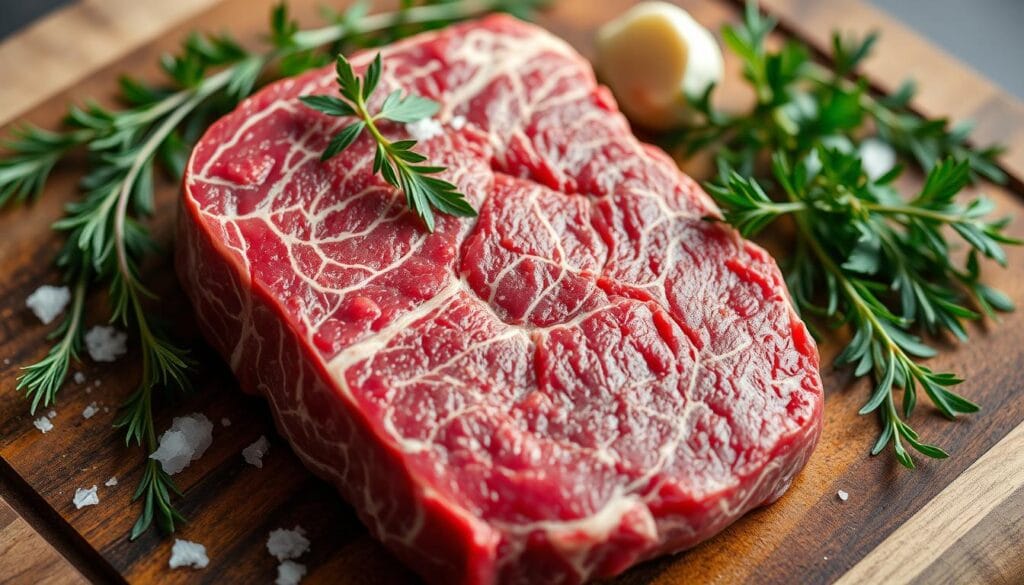
| Characteristic | Description |
|---|---|
| Marbling | Fine marbling enhances flavor and tenderness |
| Thickness | Approximately ¾ to 1 inch |
| Color | Bright red when fresh |
| Versatility | Suitable for grilling, sautéing, salads, and sandwiches |
| Tenderness Rating | High, comparable to rib-eye steaks |
The Importance of the Beef Loin Flat Iron Steak Label
Meat labeling is key to better cooking and dining. The label on a beef loin flat iron steak gives you important details. These details help you choose quality, taste, and align with your values.
Key Information on the Label
The label on a beef loin flat iron steak is your guide. It tells you what you’re buying. Key points include:
- Cut Name: Shows the specific meat cut.
- Grade: Tells you the beef quality, affecting taste and tenderness.
- Nutritional Information: Gives calories, fat, and protein details.
- Country of Origin: Tells where the beef comes from.
Why Reading Labels Matters
Knowing the label’s importance improves your cooking. It helps you match the steak with your diet. Also, it lets you choose sustainable meat sources. This makes your cooking choices better.
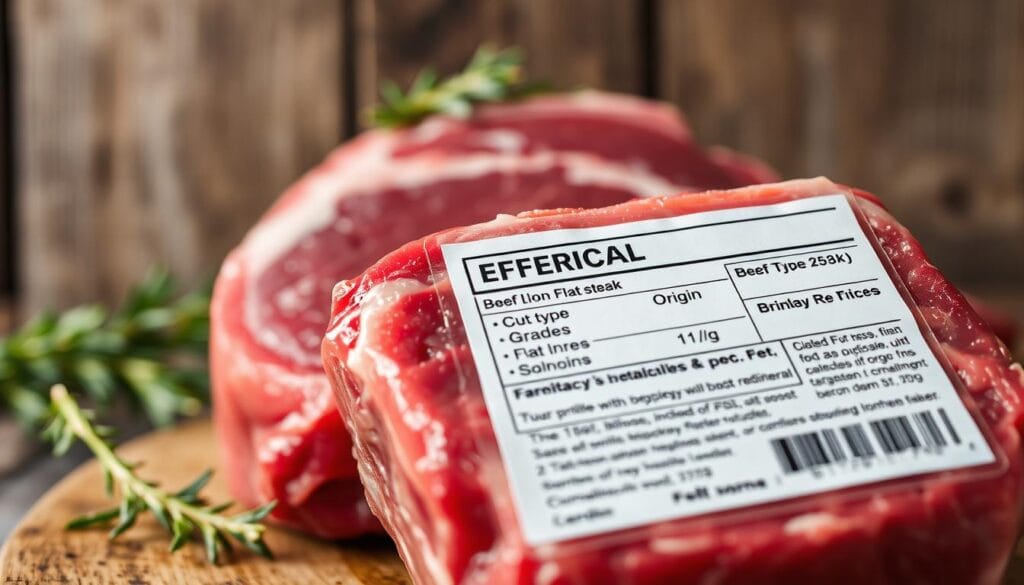
| Label Information | Details |
|---|---|
| Calories | 400-600 kcal |
| Fat | 25-40 g |
| Protein | 40-60 g |
| Preparation Time | 3-4 minutes per side for medium-rare |
| Resting Time | 5-10 minutes post-cooking |
Understanding the USDA Grading System
The USDA grading system is key in figuring out beef quality, like flat iron steak. It looks at marbling, tenderness, and maturity. Knowing these grades helps you pick the best beef.
The USDA grades beef as Prime, Choice, and Select. Each grade shows different quality and taste levels.
How Grades Affect Quality
The beef grade affects its quality a lot. Prime beef, found in fancy restaurants, has lots of marbling. This makes it very tender and flavorful, perfect for grilling.
Choice-grade beef comes from young, active cows. It has less marbling than Prime but is tasty and good quality. It works well in many recipes.
Select-grade beef is leaner with little marbling. It’s okay but might taste better with marinating.
Common Grades Explained: Prime, Choice & Select
| Grade | Fat Content | Characteristics |
|---|---|---|
| Prime | 8-13% | Highest marbling, tender, ideal for grilling |
| Choice | 4-10% | Good flavor, less marbling, versatile for various dishes |
| Select | 2-4% | Leaner, less tender, may need marination for better flavor |
Choosing beef with a Choice or higher grade means better tenderness and taste. Knowing the USDA grading system helps you pick the best cuts for your meals.
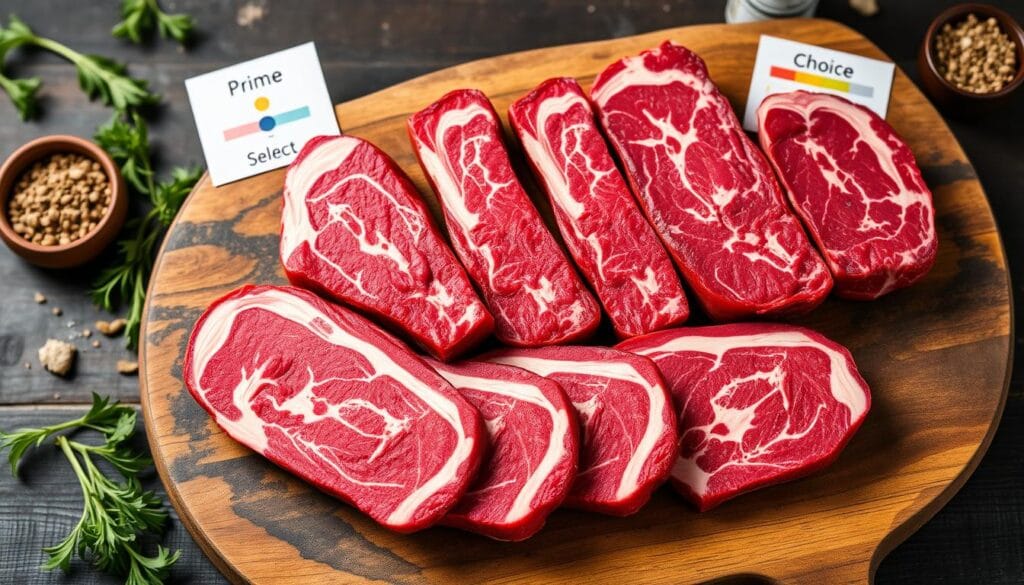
Key Elements of Your Beef Loin Flat Iron Steak Label
Your beef loin flat iron steak label has important details to help you choose wisely. Knowing what’s on the label helps you pick the perfect cut for your meal. The label shows the cut name, where it comes from, and its nutritional info. These details can shape your decision and how you cook it.
Cut Name and Identification
The label clearly says it’s flat iron steak. This cut is almost as tender as filet mignon. Knowing this ensures you get a high-quality steak that’s tender and flavorful. It’s perfect for many recipes.
Country of Origin and Sourcing
The label tells you where the steak comes from. This info helps you understand how it was raised. Some countries have stricter rules for animal care, which can improve the beef’s quality. This lets you choose beef that fits your values, like being sustainable and caring for animals.
Nutritional Information
The label also shows the steak’s nutritional facts. A serving of flat iron steak has about 23-26 grams of protein, great for muscles. It’s also low in fat, with less than 10 grams per 3.5 ounces. Plus, it’s a good source of iron, zinc, and B vitamins, helping with energy and immune health. Knowing this helps you match your steak with your diet goals.
Cooking Instructions for Flat Iron Steak
Cooking a beef loin flat iron steak right is key to getting it tender and tasty. This cut is known for its rich marbling. It does well with different cooking methods. Here are some top ways and a steak temperature guide to help you cook it perfectly.
Best Cooking Methods
There are many ways to cook flat iron steak. Each method brings out different flavors and textures. This makes it a great choice for any meal.
- Grilling: Great for getting a nice char and smoky taste. Use a hot grill for the best results.
- Pan-searing: This stovetop method is perfect for caramelizing the steak. Use a heavy skillet and high heat.
- Broiling: Quick cooking method that gives a nice crust on the outside.
Recommended Cooking Temperatures
It’s important to check the steak’s temperature to enjoy it. A meat thermometer helps you get it just right. Here’s a guide for cooking temperatures:
| Doneness Level | Temperature Range | Cooking Time (Approx.) |
|---|---|---|
| Rare | 120-125°F | 3-4 minutes per side |
| Medium-Rare | 130-135°F | 4-6 minutes per side |
| Medium | 140-145°F | 5-7 minutes per side |
Let the steak rest for 5-10 minutes after cooking. This lets the juices spread out, making it more flavorful and tender. The flat iron steak is also a good source of protein, with about 23-26 grams per serving. Try these cooking methods and temperatures to enjoy its great taste and texture.
Flavor Profiles and Marinades
The beef loin flat iron steak has a rich and robust flavor. The right seasonings and marinades can enhance it beautifully. Learning how to improve this cut can make your meals better.
With its flavorful profile, it pairs well with many seasonings. This makes every bite a delight.
Seasoning Suggestions
Seasoning your flat iron steak can be simple yet effective. Try using:
- Salt and freshly cracked black pepper
- Fresh herbs like rosemary or thyme
- Garlic powder for added depth
- Smoked paprika for a touch of smokiness
These seasonings complement the steak’s natural flavor. They make each bite savory and satisfying.
Popular Marinade Recipes
Marinades can add a lot of flavor to your steak. They make the beef loin flat iron steak tender and tasty. Here are two popular marinades:
- Soy Sauce Marinade: Mix 2 tablespoons of soy sauce, minced garlic, and olive oil for a umami kick.
- Balsamic Marinade: Combine balsamic vinegar, olive oil, and honey for a sweet and tangy taste. Marinate for 30 minutes to an hour to soak up the flavors.
These marinades not only boost the steak’s flavor but also make meals delicious. A simple marinade can make your barbecue night unforgettable with friends and family.
Health Benefits of Beef Loin Flat Iron Steak
The beef loin flat iron steak is not just tasty but also packed with health benefits. It’s a nutrient-rich food that can help balance your diet. It’s a top choice for those who want to stay fit and healthy.
Protein Content and Nutritional Value
Beef is known for its high protein, which is key for muscle repair and growth. A flat iron steak can give you up to 26 grams of protein. This makes it a great choice for a filling meal.
This steak also has iron, zinc, and B vitamins. These nutrients are important for energy, immune health, and overall well-being.
Essential Vitamins and Minerals
The vitamins and minerals in beef loin flat iron steak add to its health benefits. It’s rich in iron, which helps carry oxygen in the blood. This is important for stamina and performance.
Zinc supports a healthy immune system, and B vitamins help turn food into energy. Adding flat iron steak to your meals can meet your nutritional needs while being delicious. For more recipe ideas, check out what to do with chunks of Black Angus.
Sustainability and Ethical Considerations
When picking beef, think about sustainability and ethics. You can help animals and the planet by choosing wisely. Look for “grass-fed” or “organic” labels to support your values.
Understanding Sustainable Beef Practices
Sustainable beef aims to protect the environment and treat animals well. Look for “Certified Humane” or “Global Animal Partnership” labels. These ensure beef comes from farms that follow strict standards.
Many people choose sustainable beef, with 66% considering it when buying meat. Grass-fed beef has more Omega-3s, which is good for you. It’s pricier, but it’s worth it for the quality.
Choosing Grass-Fed vs. Grain-Fed
Grass-fed vs grain-fed beef is a big debate. Grass-fed is leaner and might taste better. Grain-fed is softer and more common.
USDA Prime beef is the most expensive, but it’s tender and flavorful. USDA Choice and Select are cheaper but good too. Always check for USDA certifications to ensure quality and ethics.
| Beef Type | Marbling | Price Range (per pound) | Health Benefits |
|---|---|---|---|
| Grass-Fed | Lean with high Omega-3 | $10 – $30 | Higher Omega-3 fatty acids |
| Grain-Fed | Higher marbling | $8 – $20 | Juicier and more tender |
| USDA Prime | Exceptional marbling | $15 – $30 | Superior tenderness |
| USDA Choice | Good balance | $10 – $20 | Adequate flavor and tenderness |
| USDA Select | Lean | $8 – $15 | Lower fat content |
Your choices matter for the beef industry’s future. By choosing sustainable options, you improve your meals and support animal welfare and the environment.
Tips for Selecting Quality Flat Iron Steak
Choosing the right flat iron steak is key. Look for freshness signs like color and texture. A bright red steak with marbling means it’s tender and tasty. Also, check if the packaging is dry, which shows it’s fresh.
Quality packaging should have clear labels. These labels should show the packaging date and processing details.
Recognizing Freshness Indicators
Check the packaging date on the label. Meat should be consumed within 3-5 days if stored at 40°F or below. A firm texture and vibrant color mean it’s fresh.
If you can’t cook it right away, marinate it. Marinating for 2-4 hours can make it even more tender and flavorful.
What to Look for in Packaging
Look closely at the packaging. It should have USDA grading, like USDA Choice or higher. Avoid packages with vague terms like “premium” without clear standards.
Also, check the sodium content. It affects the dish’s taste and health value. Good packaging keeps the meat fresh, ensuring great taste and texture. Follow these tips for a better cooking experience. For more ideas, check out this foolproof recipe.
FAQ
What is a beef loin flat iron steak?
How do I read a beef loin flat iron steak label?
Is flat iron steak a good cut of beef?
What are the best cooking methods for flat iron steak?
What marinades work well with flat iron steak?
How should I choose a quality flat iron steak?
What are the nutrition facts for flat iron steak?
What does the USDA grading system tell me about my flat iron steak?
Is flat iron steak considered a cheap cut?
How should I store flat iron steak?
Conclusion
Knowing your beef loin flat iron steak label is key to cooking success. It helps you understand quality and make better choices. This summary gives you the basics to pick the best cuts for great taste and tenderness.
Learning about grading, nutrition, and cooking methods lets you pick top steaks. Whether it’s USDA Prime’s marbling or protein for muscle repair, each detail helps make tasty dishes. Knowing the label means better buys and more fun cooking.
Choosing, cooking, and enjoying flat iron steak is an art. With these tips, you’ll make meals that please you and impress others. Start your beef cooking journey with informed choices from the label!

